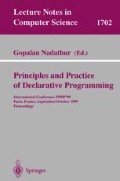Abstract
Interaction nets are graphical rewriting systems which can be used as either a high-level programming paradigm or a low-level implementation language. However, an operational semantics together with notions of strategy and normal form which are essential to reason about implementations, are not easy to formalize in this graphical framework. The purpose of this paper is to study a textual calculus for interaction nets, with a formal operational semantics, which provides a foundation for implementation. In addition, we are able to specify in this calculus various strategies, and a type system which formalizes the notion of partition used to define semi-simple nets. The resulting system can be seen as a kernel for a programming language, analogous to the λ-calculus.
Access this chapter
Tax calculation will be finalised at checkout
Purchases are for personal use only
Preview
Unable to display preview. Download preview PDF.
References
Abramsky, S.: Computational Interpretations of Linear Logic. Theoretical Computer Science 111, 3–57 (1993)
Ariola, Z.M., Klop, J.W.: Lambda calculus with explicit recursion. Information and Computation 139(2), 154–233 (1997)
Banach, R.: The algebraic theory of interaction nets. Technical Report UMCS-95- 7-2, University of Manchester (1995)
Bawden, A.: Connection graphs. In: Proceedings of ACM Conference on Lisp and Functional Programming, pp. 258–265 (1986)
Danos, V., Regnier, L.: The structure of multiplicatives. Archive for Mathematical Logic 28, 181–203 (1989)
Fernández, M.: Type assignment and termination of interaction nets. Mathematical Structures in Computer Science 8(6), 593–636 (1998)
Fernández, M., Mackie, I.: Coinductive techniques for operational equivalence of interaction nets. In: Proceedings of the 13th Annual IEEE Symposium on Logic in Computer Science (LICS 1998), pp. 321–332. IEEE Computer Society Press, Los Alamitos (1998)
Fernández, M., Mackie, I.: Interaction nets and term rewriting systems. Theoretical Computer Science 190(1), 3–39 (1998)
Gonthier, G., Abadi, M., Lévy, J.-J.: The geometry of optimal lambda reduction. In: Proceedings of the 19th ACM Symposium on Principles of Programming Languages (POPL 1992), pp. 15–26. ACM Press, New York (1992)
Honda, K.: Types for dyadic interaction. In: Best, E. (ed.) CONCUR 1993. LNCS, vol. 715. Springer, Heidelberg (1993)
Klop, J.-W., van Oostrom, V., van Raamsdonk, F.: Combinatory reduction systems, introduction and survey. Theoretical Computer Science 121, 279–308 (1993)
Lafont, Y.: Interaction nets. In: Proceedings of the 17th ACM Symposium on Principles of Programming Languages (POPL 1990), pp. 95–108. ACM Press, New York (1990)
Lamping, J.: An algorithm for optimal lambda calculus reduction. In: Proceedings of the 17th ACM Symposium on Principles of Programming Languages (POPL 1990), pp. 16–30. ACM Press, New York (1990)
Laneve, C.: Optimality and Concurrency in Interaction Systems. PhD thesis, Dipartmento di Informatica, Universitá degli Studi di Pisa (1993)
Mackie, I.: Static analysis of interaction nets for distributed implementations. In: Van Hentenryck, P. (ed.) SAS 1997. LNCS, vol. 1302, pp. 217–231. Springer, Heidelberg (1997)
Mackie, I.: YALE: Yet another lambda evaluator based on interaction nets. In: Proceedings of the 3rd ACM SIGPLAN International Conference on Functional Programming (ICFP 1998), pp. 117–128. ACM Press, New York (1998)
Pinto, J.S.: An abstract machine for interaction nets, École Polytechnique (1999)
Yoshida, N.: Graph notation for concurrent combinators. In: Ito, T., Yonezawa, A. (eds.) TPPP 1994. LNCS, vol. 907, pp. 364–397. Springer, Heidelberg (1995)
Yoshida, N.: Minimality and separation results on asynchronous mobile processes: Representability theorems by concurrent combinators. In: Sangiorgi, D., de Simone, R. (eds.) CONCUR 1998. LNCS, vol. 1466, pp. 131–146. Springer, Heidelberg (1998)
Author information
Authors and Affiliations
Editor information
Editors and Affiliations
Rights and permissions
Copyright information
© 1999 Springer-Verlag Berlin Heidelberg
About this paper
Cite this paper
Fernández, M., Mackie, I. (1999). A Calculus for Interaction Nets. In: Nadathur, G. (eds) Principles and Practice of Declarative Programming. PPDP 1999. Lecture Notes in Computer Science, vol 1702. Springer, Berlin, Heidelberg. https://doi.org/10.1007/10704567_10
Download citation
DOI: https://doi.org/10.1007/10704567_10
Publisher Name: Springer, Berlin, Heidelberg
Print ISBN: 978-3-540-66540-3
Online ISBN: 978-3-540-48164-5
eBook Packages: Springer Book Archive

